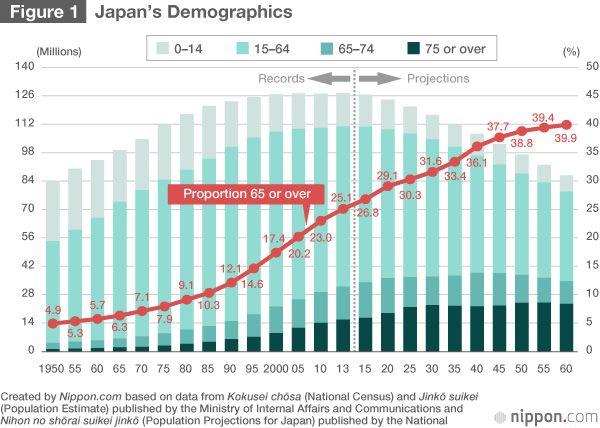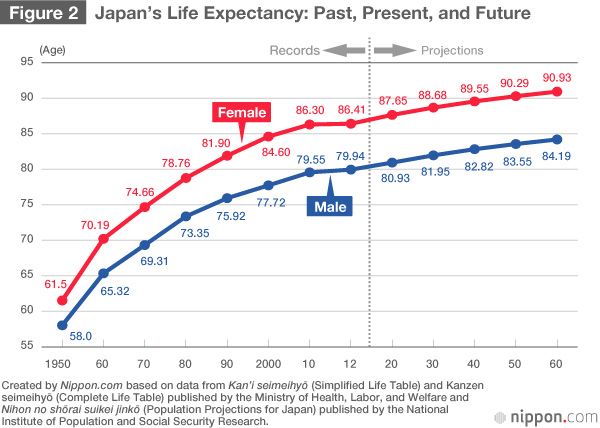
Graying Japan to Face Unprecedented Challenges
Society- English
- 日本語
- 简体字
- 繁體字
- Français
- Español
- العربية
- Русский
In August 2014, Saitama resident Momoi Sakari was confirmed as the world’s oldest living man by Guinness World Records at the age of 111 years and 196 days. Checking procedures began in June after the death of Alexander Imich, the American who was the previous record holder, at 111 years and 124 days.
Shortly before September 15, the national holiday Respect for the Aged Day, the Ministry of Health, Labor, and Welfare announced a new record population of 58,820 centenarians. This was a rise of more than 4,000 on the previous year and the forty-fourth consecutive annual increase. Japan’s oldest woman was 116-year-old Ōkawa Misao of Osaka, the world’s oldest living person, and Japan’s oldest man was Momoi. The ministry’s report gave further corroboration of the rapid aging of society.
Life Expectancy for Men Now Over 80
Life expectancy was just 46.92 for Japanese men and 49.63 for Japanese women in 1935, but has lengthened significantly since. In 2013, Japanese male life expectancy rose above 80 for the first time, increasing 0.27 to 80.21, according to the Health Ministry’s simplified life table. This puts Japanese men fourth highest worldwide, one place higher than 2012, after Hong Kong (80.9), Iceland (80.5), and Switzerland (80.5).
Female life expectancy rose 0.2 to a new record of 86.61, the world’s highest for the second year running, ahead of Hong Kong (86.6), Spain (85.1), France (85.0), and Switzerland (84.7). One reason behind these increases is lower mortality at all ages from diseases such as cancer, heart disease, strokes and other cerebrovascular disease, and pneumonia.
Baby Boomers Turn 65
The World Health Organization recognizes aging societies as a global trend, with world life expectancy in 2012 at 72.7 for women and 68.1 for men, six years longer than in 1990. However, longevity still depends greatly on where a person is born, with economic factors playing a major part.
In Japan, the Cabinet Office’s 2014 white paper on the nation’s aging society reported that in 2013 the number of people who were 65 or over rose by 1.1 million to 33.0 million. This means that 25.9% of the country’s total population of 127.1 million were senior citizens, up 0.9% from the previous year. This figure, a new record, has surged as Japan’s baby boomers (born between 1947 and 1949) turn 65. Of those who were 65 or over, 14.2 million were men and 18.8 million were women. A full eighth of the population, or 12.5%,were 75 or over (15.9 million) and 3.8% were 85 or over (4.8 million).
The aging of Japanese society has already reached a level beyond that of any other country, but it is the speed of the process that is particularly worth noting. The United Nations defines a country as aging when 7% of its population is 65 or over. In Japanese there are terms for a society including 7% (kōreika shakai, or a society in the process of aging), 14% (kōrei shakai, an aged society), and 20% (chōkōrei shakai, a super-aged society) senior citizens. Japan moved from 7% to 14% in the short span of 24 years between 1970 and 1994. By contrast, in Europe this stage was quickest in Germany, where it took 42 years from 1930 to 1972, while in France it took all of 114 years, from 1865 to 1979.
The senior population is predicted to continue to grow and peak at 38.8 million in 2042, according to the Population Projections for Japan prepared by the National Institute of Population and Social Security Research in January 2012. It will then start to decline, but the proportion of senior citizens will continue to grow. As a result, this proportion is projected to reach 39.9% by 2060, at which time the 75-or-over population will be 26.9%. Life expectancy is predicted to be 84.19 for males and 90.93 for females.
Breaking New Ground
As Japan’s birth rate continues to drop, one concern is the shrinking working-age population. The Ministry of Internal Affairs and Communications estimated that the working population would total 79.0 million in 2013, falling below 80 million for the first time in 32 years. A smaller labor force will surely reduce Japan’s international competitiveness. It will also face a higher relative burden, as the 2.3 workers supporting every senior via social security payments in 2015 are projected to drop to 1.3 by 2060. Discontent is growing among the younger generation and there are fears this could develop into a serious social problem.
Another issue is the cost of social security, which in fiscal 2011 reached a record ¥107.5 trillion. In 1970, payouts represented just 5.8% of the national income. By 2011, though, they had ballooned to 31.0%, with more than two-thirds (¥72.2 trillion) spent on senior-related social security. The country’s inflating welfare bill comes at a time when it urgently needs to reduce its fiscal deficit.
Japan will break new ground as a nation with a never-before experienced life expectancy and senior population. It will have to meet the challenges of a greater number of people with Alzheimer’s disease and other forms of dementia, leading to expansion in “silver” industries like medical and nursing care for seniors. The national government and local administrations are setting targets and implementing new initiatives to help ensure that long lives can be lived in good health. With no models from other countries to refer to, it remains to be seen how Japan’s “super-aged society” will develop.


Japan’s Aging Population
| Population Millions | Total | Male | Female | |
|---|---|---|---|---|
| Total population | 127.3 | 61.9 | 65.4 | |
| Seniors (65 or over) | 31.9 | 13.7 | 18.2 | |
| 65–74 | 16.3 | 7.7 | 8.6 | |
| 75 or over | 15.6 | 6.0 | 9.6 | |
| Working-age population (15–64) | 79.0 | 39.8 | 39.2 | |
| Children (0–14) | 16.4 | 8.4 | 8.0 | |
| Percentage | Total population | 100.0 | 100.0 | 100.0 |
| Seniors (65 or over) | 25.1 | 22.1 | 27.8 | |
| 65–74 | 12.8 | 12.5 | 13.1 | |
| 75 or over | 12.3 | 9.7 | 14.7 | |
| Working-age population (15–64) | 62.1 | 64.3 | 59.9 | |
| Children (0–14) | 12.9 | 13.6 | 12.2 |
Notes: Data as of October 1, 2013. Created by Nippon.com based on data from Jinkō suikei (Population Estimate) published by the Ministry of Internal Affairs and Communications.
social security elderly demographics population aging life expectancy